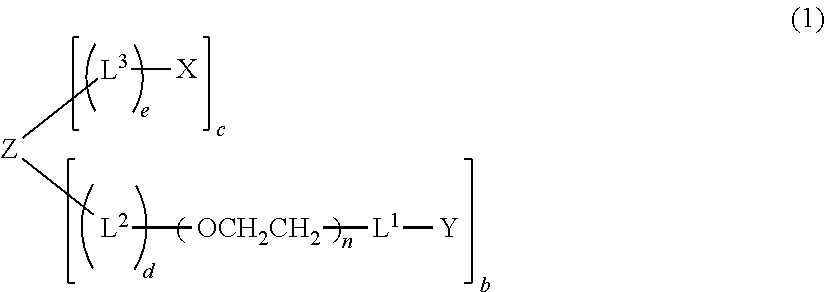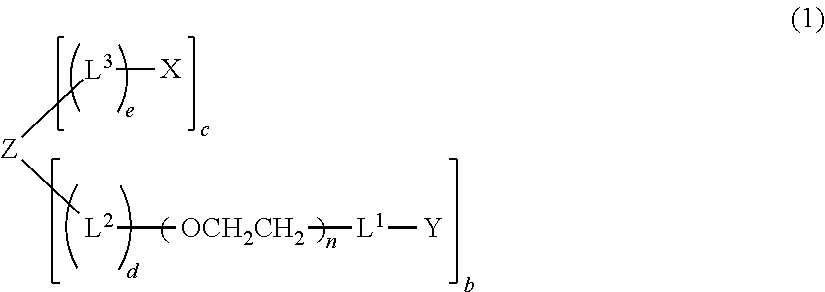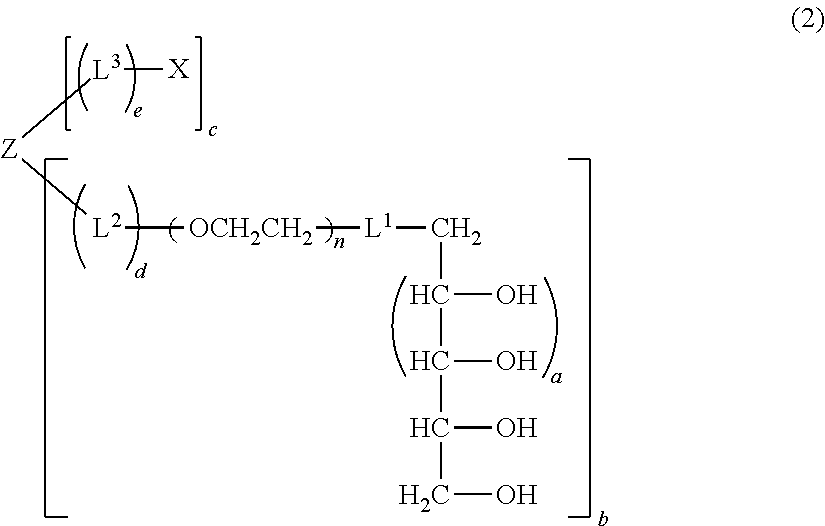Polyoxyethylene derivative having plural hydroxyl groups at terminal end thereof
a technology of polyoxyethylene and hydroxyl groups, applied in the field of polyoxyethylene derivatives, can solve the problems of short half-live, large yield drop, difficult to obtain a sufficient pharmacological effect, etc., and achieve the effects of reducing the transitional ability of each tissue, and improving the half-live in blood
- Summary
- Abstract
- Description
- Claims
- Application Information
AI Technical Summary
Benefits of technology
Problems solved by technology
Method used
Image
Examples
example 1
Synthesis of Polyoxyethylene Derivative (1)
[0223](case where L1=-O—, L3=—CH2CH2—NHCO—CH2CH2—, X=maleimido group, Z=ethylene glycol residual group, a=1, b=1, c=1, d=0, e=1, and molecular weight=about 20000)
example 1-1
Compound (5) (6): Synthesis of Diisopropylidenexylitol
[0224]In a 5 L round-bottom flask fitted with a thermometer, a nitrogen-introducing tube, and a stirrer were placed 1000 g of xylitol, 1916 g of 2,2-dimethoxypropane, and 37.5 mg of p-toluenesulfonic acid monohydrate and, with introduction of nitrogen thereinto, the reaction was carried out at 65° C. The solvent of the reaction solution was removed by distillation and purification by distillation (b.p. 108° C. / 0.15 mmHg) was performed to obtain an isomer mixture of 1,2,3,4-diisopropylidenexylitol (formula (5)) and 1,2,4,5-diisopropylidenexylitol (formula (6)). 1H-NMR (CDCl3, internal standard TMS) δ (ppm): 1.37-1.44 (12H, m, —C(CH3)2), 3.59-3.65 (1H, m, —CH—O—), 3.81-3.90 (2H, m, —CH2—O—), 3.98-4.01 (1H, m, —CH—O—), 4.04-4.10 (2H, m, —CH2—O—), 4.11-4.23 (1H, m, —CH—O—) 1H, m, —CH—O—)
example 1-2
Compound (7): Synthesis of 1,2,3,4-diisopropylidene-5-(t-butyldiphenylsilyl)xylitol
[0225]In a 2 L round-bottom flask fitted with a thermometer, a nitrogen-introducing tube, and a stirrer were placed 250 g of diisopropylidenexylitol (isomer mixture) purified in 1-1, 1000 g of dichloromethane, 26 g of 4-dimethylaminopyridine, and 109 g of triethylamine, and the whole were dissolved with introduction of nitrogen thereinto. After cooling to 10° C. or lower, 297 g of t-butylchlorodiphenylsilane was added dropwise thereto. After the dropwise addition, temperature was returned to room temperature and, after the reaction for 2 hours, a saturated aqueous sodium hydrogen carbonate solution was added and washing was performed. After dehydration over magnesium sulfate, the solvent was removed by distillation and 1,2,4,5-diisopropylidenexylitol was removed at 135° C. under reduced pressure (0.2 mmHg) to obtain 200 g of 1,2,3,4-diisopropylidene-5-(t-butyldiphenylsilyl)xylitol (formula (7)). 1H-NM...
PUM
 Login to View More
Login to View More Abstract
Description
Claims
Application Information
 Login to View More
Login to View More - R&D
- Intellectual Property
- Life Sciences
- Materials
- Tech Scout
- Unparalleled Data Quality
- Higher Quality Content
- 60% Fewer Hallucinations
Browse by: Latest US Patents, China's latest patents, Technical Efficacy Thesaurus, Application Domain, Technology Topic, Popular Technical Reports.
© 2025 PatSnap. All rights reserved.Legal|Privacy policy|Modern Slavery Act Transparency Statement|Sitemap|About US| Contact US: help@patsnap.com



